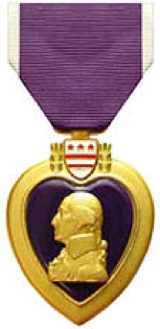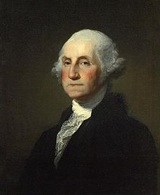George Washington and the Purple Heart

Deprived of promotion as a reward, Washington hit on the idea of an emblem awarded to troops which they would wear as a sign of their valor.
The Purple Heart has been described as the medal "available to all, desired by none." The conditions for awarding it have changed at various times, but it is bestowed upon members of the U.S. Armed Forces who have been wounded, killed or died after being wounded. Since 2008, it has also been awarded to those who died in captivity as Prisoners of War.
In this article for ArmchairGeneral.com, Steven Schultz examines the beginnings of this, America’s first award for military gallantry.
{default}Appropriately, the first American solider honored with a medal for combat action was General George Washington. On March 25, 1776, the Continental Congress awarded Washington the Congressional Gold Medal in recognition of driving British forces from Boston. However, this was not a medal worn on the uniform in the sense we think of military medals today. Washington himself devised the first American combat decoration designed to be worn by the recipient.
Washington understood the importance morale and esprit de corps played in the cohesion of a fighting force. Washington knew recognizing the heroism and valor of the common solider reinforced these qualities throughout the entire army. Initially, he recognized valor and merit through promotions and field commissions. However, in 1782, the Continental Congress ordered Washington to stop this practice as they lacked funds to pay the troops Washington promoted.
Deprived of promotion as a reward, Washington hit on the idea of an emblem awarded to troops which they would wear as a sign of their valor. Thus, on August 7, 1782, Washington issued a General Order establishing the Badge of Military Merit. The General Order read in part:
The General, ever desirous to cherish virtuous ambition in his soldiers as well as foster and encourage every species of military merit, directs that whenever any singularly meritorious action is performed, the author of it shall be permitted to wear on his facings, over his left breast, the figure of a heart in purple cloth or silk edged with narrow lace or binding. Not only instances of unusual gallantry but also of extraordinary fidelity and essential service in any way shall meet with due reward. The name and regiment of the persons so certified are to be enrolled in a Book of Merit which shall be kept in the orderly room…Men who have merited this distinction to be suffered to pass all guards and sentinels which officers are permitted to do. The order to be retroactive to the earliest stages of the war, and to be a permanent one…The road to glory in a patriot army and a free country is thus open to all.
Its shape and color provide the name by which we know it today: the Purple Heart. The order called for a Board of Officers to review cases of those nominated for the award.
 Despite Washington’s clear directions that the award be permanent, a Board of Officers met only one time, on April 24, 1783. The board recommended approval of two awards. General Washington concurred in General Orders of April 27, 1783, and the awards were presented on May 3, 1783.
Despite Washington’s clear directions that the award be permanent, a Board of Officers met only one time, on April 24, 1783. The board recommended approval of two awards. General Washington concurred in General Orders of April 27, 1783, and the awards were presented on May 3, 1783.
Sergeant Elijah Churchill and Sergeant William Brown each received the Badge of Military Merit. Sgt. Churchill, who served with the 4th Troop of the 2nd Regiment of Light Dragoons, merited the award for "conspicuous gallantry, firmness and address" in attacks against the British supply depots of Fort George and Fort Slongo on Long Island. Sgt. Brown, a member of Captain Samuel Comstock’s Company, 5th Connecticut Regiment of the Continental Line, earned the Badge through leading a "forlorn hope" assault against a British redoubt at Yorktown on October 14, 1781.
Only one other soldier received the Badge of Military Merit, Sergeant Daniel Bissell of Captain David Humphrey’s Company, 2nd Connecticut Regiment of the Continental Line. General Washington, learning of Sgt. Bissell’s "fidelity, perseverance and good sense," personally ordered Bissell awarded the Badge on June 10, 1783.
With the end of the Revolutionary War, the army downsized to fewer than 1,000 men and the Badge of Military Merit fell into disuse. Not until the Civil War and the creation of the Medal of Honor did American troops again receive medals in recognition of combat valor.
The Badge of Military Merit languished in relative obscurity until it came to light during a War Department review of records in connection with preparations for the bicentennial of George Washington’s birth. By presidential directive, War Department Order No. 3 revived the decoration on February 3, 1932, changing its name to the Purple Heart. The initial order only authorized the award for Army personnel. Not until President Roosevelt signed Executive Order Number 9227 on December 3, 1942 did Navy and Marine personnel become eligible for the award.
Initial awards of the Purple Heart went to soldiers wounded or killed during the First World War and earlier wars. From December 7, 1941, until September 2, 1942, soldiers received the award for meritorious service. Following introduction of the Legion of Merit in 1942, the Purple Heart took on the role we know today, recognizing military personnel wounded or killed as the result of direct enemy action. With the advent of "peace keeping" missions and international terrorism, Purple Heart award criteria expanded to cover troops wounded or killed in connection with these actions.
The Purple Heart is the only United States military decoration that traces its lineage back to the very founding of our nation. Many in the general public recognize the Purple Heart as an honor for troops wounded or killed in battle. General Washington would appreciate his creation still symbolizes that "the road to glory in a patriot army and a free country is thus open to all."


The Purple Heart Medal is also known by it’s recipients as the “You-Forgot-To-Duck Medal”…Wry humor at its best.
And known by many Gold Star Moms as something that is cherished but will never replace their loved ones.
RIP David L., David T., and Tony “Bull” C., Allen M.(and Crew), Stiles (and Crew), and Sykes… Afghanistan, 2008-2009
Travis L. Purple Heart recipient, 2008